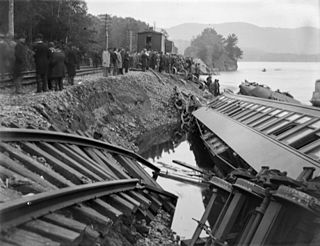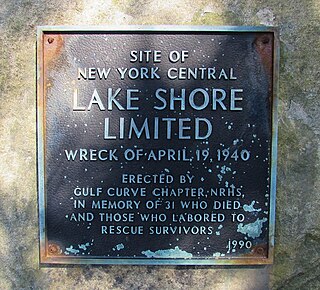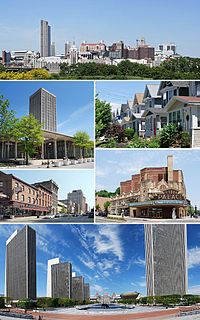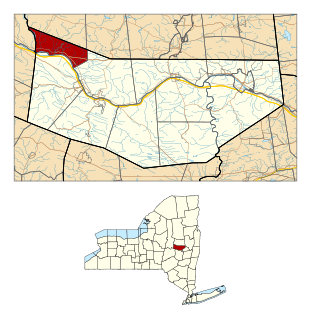
Jonathan Luther "Casey" Jones from Jackson, Tennessee, was an American railroader who worked for the Illinois Central Railroad (IC). He was killed on April 30, 1900, when his train collided with a stalled freight train near Vaughan, Mississippi. His dramatic death while trying to stop his train and save the lives of his passengers made him a hero; he was immortalized in a popular ballad sung by his friend Wallace Saunders, an African-American engine wiper for the IC.

A derailment occurs when a vehicle such as a train runs off its rails. This does not necessarily mean that it leaves its track. Although many derailments are minor, all result in temporary disruption of the proper operation of the railway system, and they are potentially seriously hazardous to human health and safety. Usually, the derailment of a train can be caused by a collision with another object, an operational error, the mechanical failure of tracks, such as broken rails, or the mechanical failure of the wheels. In emergency situations, deliberate derailment with derails or catch points is sometimes used to prevent a more serious accident.
The Federal Express was an overnight named passenger train run by the Pennsylvania Railroad and the New York, New Haven and Hartford Railroad between Washington, DC's Union Station and Boston, Massachusetts's South Station from 1912 to 1971. Train numbers on both railroads were 172 northbound and 173 southbound. At different times, its route has taken it across the Hudson River via a car float between Port Morris and Jersey City, the Poughkeepsie Bridge, and finally the Pennsylvania Tunnel and Terminal Railroad. The final routing was identical to today's high-speed Northeast Corridor.

The San Bernardino train disaster, sometimes known as the Duffy Street incident, was a combination of two separate but related incidents that occurred in San Bernardino, California, United States: a runaway train derailment on May 12, 1989; and the subsequent failure on May 25, 1989, of the Calnev Pipeline, a petroleum pipeline adjacent to the tracks which was damaged by earth-moving equipment during the crash cleanup.

The Grantham rail accident occurred on 19 September 1906. An evening Sleeping-Car and Mail train from London Kings Cross to Edinburgh Waverley hauled by Ivatt 'Atlantic' No 276 derailed, killing 14. The accident was never explained; the train ran through Grantham station, where it was scheduled to stop, and derailed on a set of points on a sharp curve at the end of the platform, which at the time had been set for a freight train. No reason was ever established as to why the train did not stop as scheduled, or obey the Caution and Danger signals. Rolt (1956) described it as "the railway equivalent of the mystery of the Marie [sic] Celeste".

The Shrewsbury rail accident occurred on 15 October 1907. An overnight Sleeping-Car and Mail train from Manchester to the West of England derailed on the sharply curved approach to Shrewsbury station, killing 18 people.

The Angola Horror train wreck occurred on December 18, 1867, just after 3 p.m. when the last coach of the Buffalo-bound New York Express of the Lake Shore Railway derailed at a bridge, slid down into a gorge and caught fire in Angola, New York, killing approximately 49 people.
The Connellsville train wreck was a rail accident that occurred on December 23, 1903, on the Baltimore and Ohio Railroad near Connellsville, Pennsylvania. The Duquesne Limited, a passenger train, derailed when it struck a load of timber lying on the tracks. The timber had fallen from a freight train minutes before the collision. The crash resulted in 64 deaths and 68 injuries.

The Garrison train crash occurred on October 24, 1897, in Garrison, New York, on a Sunday morning, at approximately 5:47 am, when train No. 46 of the New York Central & Hudson River Railroad derailed near King's Dock of the Hudson River division, about one and three-quarters miles south of Garrison. 19 people were killed, all but one of whom drowned when the embankment gave way plunging the train into the Hudson River. Witnesses described feeling between one and three "thuds" before three of the five sleeper cars fell into the river. Several witnesses described seeing a "hole" in the trackbed after the accident, however, the cause of this was not determined. Early speculation blamed a large explosion of dynamite as the cause of the train's derailment. Two weeks previously, the same train had almost derailed near the same spot when a two-ton boulder was found on the tracks, with some believing it had been deliberately placed.

The Saint-Michel-de-Maurienne derailment of December 12, 1917 was a railway accident involving a troop train carrying at least 1,000 French soldiers on their way home for leave from the Italian front in World War I. A derailment as the train descended the Maurienne valley rail line caused a catastrophic crash and subsequent fire in which approximately 675 died. France's deadliest rail accident, it occurred on the Culoz–Modane railway line, part of the Fréjus Railway.
The Dominguez Canyon rail crash, also known as the Wells Gulch rail crash, was a train crash in Colorado in 1937 that killed the engineer and the fireman.
The 1953 Pennsylvania Railroad train wreck was a railway accident in Union Station in Washington, D.C. on January 15, 1953. The brakes on the cars of the Federal Express, a passenger and mail train operated by the Pennsylvania Railroad, malfunctioned and the train crashed into the station, jumped the passenger platform, and plunged through the floor of the passenger terminal into the basement of the train station. There were no deaths, and only 43 people were injured.

The 1953 New York Central Railroad accident was a railway accident involving the New York Central Railroad which occurred on the four track main line 2.4 miles east of Conneaut, Ohio at 10:02 P.M. on March 27, 1953.

The 1990 Back Bay, Massachusetts train collision was a collision between an Amtrak passenger train, the Night Owl, and a Massachusetts Bay Transportation Authority (MBTA) Stoughton Line commuter train just outside Back Bay station in Boston, Massachusetts. An investigation by the National Transportation Safety Board (NTSB) found that the Amtrak train entered a speed-restricted curve at excessive speed, causing the train to derail and crash into the MBTA commuter train on an adjoining track. Although no one was killed in the accident, 453 people were injured and Back Bay station was closed for six days. Total damage was estimated at $14 million. The accident led to new speed restrictions and safety improvements in the vicinity of Back Bay and a revamp of Amtrak's locomotive engineer training program.
On April 14, 1907 a northbound freight train, No.23, of the New York Central and Hudson River Railroad, operating on the Rome and Richland branch of the former Rome, Watertown and Ogdensburg Railroad crashed when the bank on the lower side of the track failed and a section slid down the hill undermining the track. The accident occurred approximately 2.5 miles south of Blossvale, a hamlet in the Oneida County, New York, town of Annsville. The sixty-car freight train, carrying coal and other freight was pulled by engines No. 1726 and 1863. Both engines plunged down the sixty foot embankment. The lead engine came to rest in an inverted position while the second engine was on its side. Both engines and several cars were destroyed by fire. In addition to the two engines, a total of fifteen cars derailed.

A train crash with fatalities occurred shortly after 11:30 p.m. on April 19, 1940, when a first-class westbound Lake Shore Limited operated by the New York Central Railroad, derailed near Little Falls, New York, United States. The accident was later found to have occurred due to excessive speed on the Gulf Curve, the sharpest on the Central's lines. It killed 31; an additional 51 were injured.

On December 18, 2017, Amtrak Cascades passenger train 501 derailed near DuPont, Washington, United States. It was the inaugural run on the Point Defiance Bypass, a new passenger rail route south of Tacoma, Washington. The bypass was intended to reduce congestion and separate passenger and freight traffic, and was designed for faster speeds and shorter travel times than the previous route used by Cascades.





















